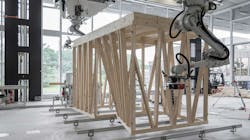Video: Swiss Researchers Use Robots to Frame House
Researchers at ETH Zurich University in Switzerland are using a new method for digital timber construction in a real project for the first time.
The load-bearing timber modules, which are prefabricated by robots, will be assembled on the top two floors at the DFAB HOUSE construction site.
The DFAB HOUSE is a three-story residential prototype unit eight ETH professors have been working on to show how multiple innovative digital construction processes are being combined.
The National Centre of Competence in Research (NCCR) Digital Fabrication and ETH have developed a new, digital timber construction method that enables efficient construction and assembly of geometrically complex timber modules, called Spatial Timber Assemblies. It is the first large-scale architectural project to use the construction robots developed by ETH Zurich’s new Robotic Fabrication Laboratory.
Watch:
The robot first takes a timber beam and guides it while it is sawed to size. After an automatic tool change, a second robot drills the required holes for connecting the beams. In the final step, the two robots work together and position the beams in the precise spatial arrangement based on the computer layout. To prevent collisions when positioning the individual timber beams, the researchers have developed an algorithm that constantly recalculates the path of motion for the robots according to the current state of construction. Workers then manually bolt the beams together.
Unlike traditional timber frame construction, Spatial Timber Assemblies can manage without reinforcement plates because the required rigidity and load-bearing result from the geometric structure. Not only does this save material; it also opens up new creative possibilities. A total of six spatial, geometrically unique timber modules will be prefabricated in this way for the first time. Lorries will then transport them to the DFAB HOUSE construction site at the NEST in Dübendorf, where they will be joined to build a two-storey residential unit with more than 100 m2 of floor space. The complex geometry of the timber construction will remain visible behind a transparent membrane façade.
The robots use information from a computer-aided design model to cut and arrange the timber beams. This method was specially developed during the project and uses various input parameters to create a geometry consisting of 487 timber beams in total.
Matthias Kohler, professor of architecture and digital fabrication at ETH Zurich, said, “If any change is made to the project overall, the computer model can be constantly adjusted to meet the new requirements. This kind of integrated digital architecture is closing the gap between design, planning and execution.”
- DFAB HOUSE - Digitally designed, planned and built
Eight ETH Zurich professors are working together with industrial partners to build DFAB HOUSE, a three-storey residential unit that is part of Empa and Eawag’s NEST research and innovation platform in Dübendorf.
The fabrication of the mesh mould wall in May 2017 was the starting shot for the world’s first building to combine multiple innovative digital construction processes under a single roof. Since then, two other digitally designed and fabricated building components were made ready for production and coordinated digitally within the overall project.
The automated Smart Dynamic Casting coordination system has already been used at ETH to prefabricate concrete façade posts designed specifically for the loading conditions of the building’s glass façade. A so-called “smart slab”, a statically optimized concrete floor slab, is currently in pre-production. Researchers are using large-format 3D sand printing for its formwork. By bringing these elements together with Spatial Timber Assemblies, a unique combination will be materializing at DFAB HOUSE – which will open in autumn 2018.
Image copyright Gramazio Kohler Research, ETH Zurich. Used with permission.
